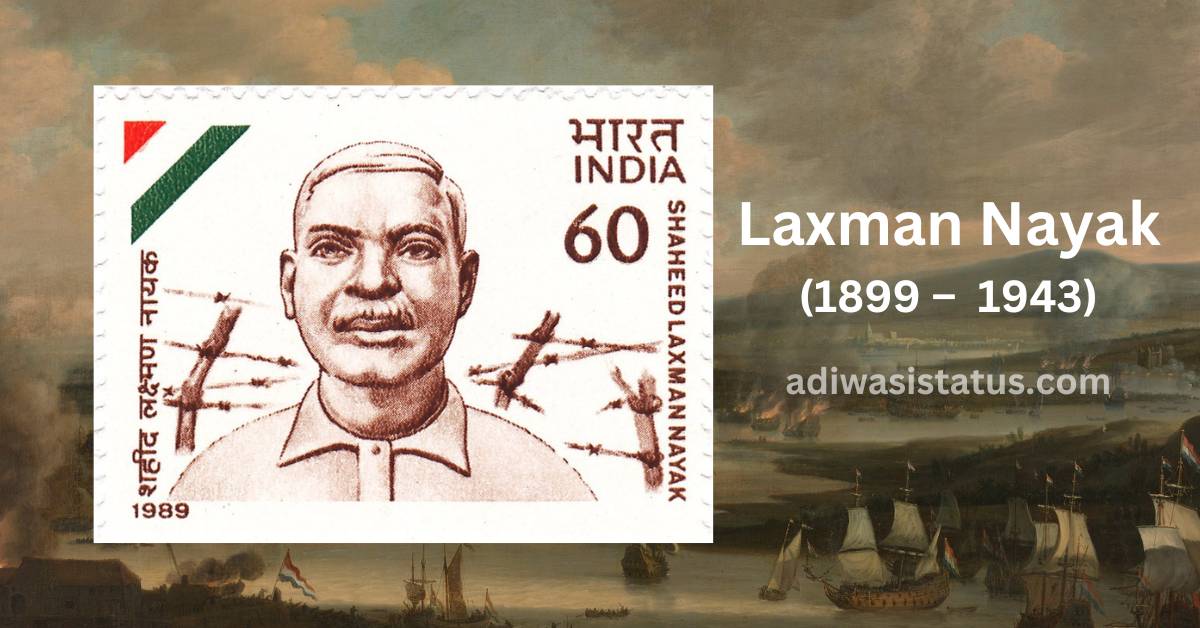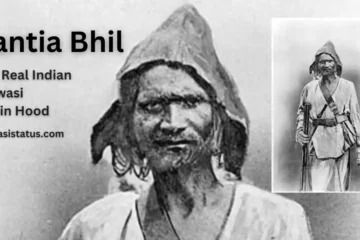Johar Friends, Today, we will delve into the inspiring story of a forgotten Adivasi hero from Odisha who valiantly fought for India’s independence: The Inspirational Journey of Laxman Nayak.
India’s hard-fought battle for independence from the clutches of the British Raj spans over two centuries, marked by immense sacrifices and unwavering determination. Among the countless brave souls who contributed to this struggle, some gained well-deserved recognition, while others, like Odisha-born Shaheed Laxman Nayak, have sadly faded into relative obscurity. In this narrative, we delve into the remarkable life of Laxman Naik, a freedom fighter often referred to as the “Gandhi of Malkangiri,” shedding light on his upbringing, beliefs, activism, and the profound impact he had on India’s fight for freedom.
Early Life and Identity: A Flame of Courage Ignites
Laxman Nayak, hailed as the “Gandhi of Malkangiri,” was born on November 22, 1899, in the Tentuligumma village of Koraput district, Odisha. Raised within the Bhumiya tribe, Laxman was surrounded by a rich cultural heritage that instilled values of unity and equality. His father, Padlam Nayak, served as a ‘Mustadaar’ or tax collector, and was the village’s representative under the local chieftain of Jeypore. Laxman’s childhood, spent engaging in activities like hunting, swimming, and playing, fostered his spirit of camaraderie and openness, transcending caste barriers.
Breaking Barriers and Nurturing Knowledge
Growing up in Tentuligumma, a remote village with scarce educational and healthcare facilities, Laxman’s thirst for knowledge was ignited by his father. Despite the village’s illiteracy, Laxman’s father imparted the skills of reading and writing, opening a window to the world beyond their secluded surroundings. Laxman’s commitment to education set him apart from his contemporaries and laid the foundation for his future endeavors.
Champion of Equality and Justice
Laxman Nayak’s unwavering commitment to justice and equality was evident early on. Rejecting the norms of casteism and untouchability, Laxman shared meals with his friend Bhalu Domb, disregarding the societal constraints that dictated otherwise. This act of defiance foreshadowed his future role as a tireless advocate for the marginalized and oppressed.
From Tribesman to Leader: Laxman Naik’s Transformation
As he matured, Laxman Nayak’s journey took an unexpected turn. Mastering the intricacies of tribal witchcraft and herbal medicine, he became a “dishari” or tribal priest, rendering aid and solace to those in need. Additionally, his proficiency with a firearm, acquired from his Koya tribe friend Chandrakutia, marked his evolution from a tribesman to a multifaceted leader.
The Path to Activism: Laxman Nayak’s Association with Congress
Laxman’s encounter with Nilkantha Patra, a prominent Congress worker, propelled him further onto the path of activism. Embracing Mahatma Gandhi’s philosophy of non-violence, Laxman diligently adhered to Gandhian principles, which began to shape every aspect of his life. Joining a Congress-run training center, he acquired skills like spinning and motivated hundreds of tribals to join the Congress, catalyzing a grassroots movement.
A Stand Against Oppression: The Quit India Movement
The clarion call of Mahatma Gandhi’s Quit India Movement galvanized Laxman Nayak and hundreds of tribal companions. On August 21, 1942, Laxman led a peaceful protest of around 400 tribal individuals outside the Mathili Police station. In a defiant display of patriotism, they attempted to unfurl the national flag, a gesture met with brutal force from the authorities. Tragedy struck as the police opened fire, resulting in casualties and Laxman himself sustaining severe injuries.
Incarceration and Unjust Trial
Following the protest, Laxman Naik’s indomitable spirit endured a harsh test. Arrested and unjustly implicated in the murder of Forest Guard G. Ramayya, Laxman faced a biased legal process. Despite presenting evidence that Ramayya’s death resulted from police gunfire, Laxman was wrongfully convicted of inciting arson, riots, and causing Ramayya’s demise. The verdict, marred by a false police narrative, led to Laxman’s sentencing under IPC Section 302.
Tragedy and Legacy
Laxman Nayak’s struggle for justice culminated in a tragic fate. Transferred to Berhampur jail, he was confined to a condemned cell before his execution on March 29, 1943. His life, marked by courage, compassion, and an unyielding commitment to freedom, remains a testament to the sacrifices made by countless unsung heroes in India’s pursuit of independence.
Top 5 Facts about Laxman Naik: A Heroic Tribal Leader in India’s Freedom Struggle
- Unwavering Spirit of Resistance: Laxman Nayak, an esteemed leader of the Bhuyan tribe, emerged as a symbol of unwavering resistance against oppressive foreign rule. He fearlessly championed the cause of freedom, leading the tribal resistance movement against all odds and sacrificing his personal comfort for the greater good.
- Champion of Nonviolent Activism: Inspired by Mahatma Gandhi’s philosophy of nonviolence, Laxman Nayak adopted peaceful methods to challenge colonial authority. He ardently believed in the power of unity and mobilized tribal communities to partake in the Indian National Congress movement, spreading the message of nonviolent protest and self-reliance.
- Bold Stand During Quit India Movement: Laxman Nayak’s remarkable courage came to the forefront during the Quit India Movement of 1942. He fearlessly led a procession of tribal villagers, waving the Congress flag and chanting slogans, ultimately attempting to hoist the flag at the Matili police station. His steadfast resolve and rallying spirit inspired his fellow tribespeople to take a stand against colonial oppression.
- False Accusation and Sacrifice: Despite his commitment to nonviolence, Laxman Nayak faced false accusations and a wrongful trial. He was unjustly implicated in the murder of a forest guard, G. Ramayya. Despite presenting evidence of police gunfire causing the guard’s death, Laxman Nayak was sentenced to death under IPC Section 302. He sacrificed his life for the cause of freedom, leaving an indelible mark on India’s struggle for independence.
- Enduring Legacy and Inspiration: Laxman Nayak’s legacy continues to inspire generations. Known as the “Gandhi of Malkangiri,” he became a beacon of hope and courage for the tribal people of Koraput and its surrounding areas. His unwavering dedication, commitment to justice, and unyielding belief in the freedom of his motherland make him a revered leader and a symbol of resilience in India’s fight for independence.
Recognition: Saheed Laxman Nayak Medical College and Hospital
Saheed Laxman Nayak Medical College and Hospital, commonly known as S.L.N Medical College & Hospital, Koraput, is a government-owned medical college and hospital situated in Koraput, Odisha, India. Its origins trace back to a dispensary established in 1908. The college was officially inaugurated in the year 2017, marking the fourth Government Medical College established in Odisha. The inauguration ceremony was held on September 4, 2017, and was presided over by the Honorable Chief Minister, Shri Naveen Patnaik. Notably, it holds the distinction of being the first medical college established in the KBK (Kalahandi-Balangir-Koraput) Area.
Brief History
The hospital’s inception dates back to a dispensary that was established in the Koraput district in the year 1908. This dispensary evolved into a hospital by 1937 and later relocated to its current premises in 2004. In 2007, the institution was renamed in honor of the freedom fighter Laxman Nayak. The significant milestone of its transformation into a medical college was achieved in 2017, making it the first medical college to be inaugurated in Odisha since the establishment of MKCG Medical College and Hospital in 1962. Notably, it is also the fourth government-run medical institute in the state. In addition to its medical facilities, the college provides a fully functional gymnasium for fitness enthusiasts, and it proudly houses an indoor badminton court, catering to the sporting interests of the students.
Conclusion
The story of Laxman Nayak, the forgotten hero known as the “Gandhi of Malkangiri,” serves as a poignant reminder of the countless individuals who valiantly fought for India’s freedom. His journey, from a tribal village to the forefront of the struggle, epitomizes the resilience, dedication, and unwavering spirit that defined India’s fight against colonial oppression. Laxman Nayak’s legacy stands as an inspiration to future generations, igniting the flame of courage and reminding us of the sacrifices that paved the way for a free and independent India.
FAQ about Saheed Laxman Nayak:
Who was the father of Shaheed Laxman Nayak?
He hailed from the Bhuyan tribe of Odisha and was born in the village of Tentuliguma in the Koraput district. His father’s name, Padlam Nayak, held the position of a tribal chief and served as a ‘Mustadaar’ under the ‘Jeypore Samasthanam’ in the former Madras Presidency.
What is the laxman nayak village name?
Tentuliguma
In which movement was Laxman Nayak hanged?
Laxman Nayak was hanged during the Quit India Movement.
Who was the first tribal leader of Odisha?
The first tribal leader of Odisha is often recognized as Birsa Munda, a prominent figure in the tribal resistance movement against British colonial rule in the late 19th century.
Why is Laxman Nayak famous?
Laxman Nayak is famous for his heroic role in India’s struggle for independence, particularly within the tribal communities of Odisha. He fearlessly led the tribal resistance movement, advocating for freedom and justice against oppressive foreign rule. Nayak’s unwavering commitment to nonviolent activism, his leadership during the Quit India Movement, and his ultimate sacrifice through wrongful conviction and execution have made him a symbol of courage, resilience, and the indomitable spirit of the Indian people in their quest for liberty.
Disclaimer: This blog is intended to provide factual and respectful information about the caste, religion, and traditions of tribal communities for educational and awareness purposes only. We do not intend to offend, discriminate against, or misrepresent any individual, group, or belief system. If you identify any inaccuracies or have constructive suggestions, we welcome your feedback and appreciate your support.



